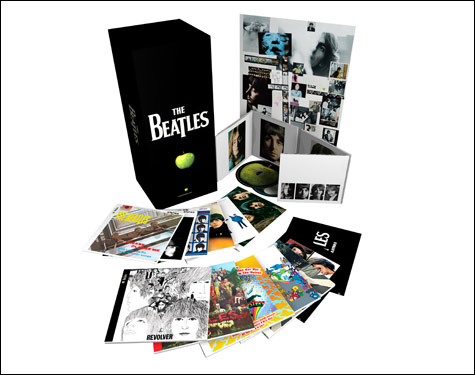
MAGICAL MASTERY:To say that they sound incredible is an understatement — both these sets offer the most vibrant Beatles experience yet. |
In 2006, Apple/EMI released the Beatles-soundtracked Cirque du Soleil companion piece
Love, which mashed together songs from the band's repertoire in stunning remastered sound. The disc was a definitive reminder that our other Beatles CDs sounded shitty and that the technology and the brainpower existed to make them so much better. Detached from vinyl's old world, we clung to our dynamically challenged transfers from 1987. Produced at the dawn of the CD era, those releases suffered from substandard fidelity, and — with the exception of the first four albums — they favored stereo over mono.
Love was the latest in a series of annual fourth-quarter Beatles releases (e.g., the Anthology sets, 1, and Live at the BBC) that managed to offer "new product" while dodging the Big Question: when will the Beatles' original catalogue get its long-overdue reissue treatment? How about now, 22 years after the first CDs were issued, 39 years after the Beatles' final official studio release, nearly one-tenth of the way into a new century, and on the purported cusp of the CD's irrelevance?

Following a four-year remastering process, the Beatles' entire studio output is being released in two decadent box sets. The Beatles contains all 13 albums plus the double-disc Past Masters singles comp in stereo, with lavish packaging, liner notes, and photos. The limited-edition Beatles in Mono box is slimmer but cutesier, offering up the bulk of the catalogue (save for Yellow Submarine, Abbey Road, and Let It Be, all stereo-only releases) as impeccable mini-LP replicas. Both sets offer the sort of multi-sensory musical experience that we've lost in the transition to a fully digital medium. (The stereo CDs are also being released individually.) With digital distribution still unannounced, you have to wonder: is Apple Corps. hoping to make CDs popular again?
To ask "Should I care?" is mere reactionary bravado — both sets are filled with moments of fog-lifting clarity and expectation-besting revelation. That the mono albums are a limited release might suggest they're for sun-deprived audiophiliacs only. False. Mono was the standard format for pop records for most of the '60s; the Beatles didn't mix exclusively in stereo until their penultimate LP. They even attended mono mixing sessions, whereas the stereo mixes were left to producer George Martin and Abbey Road's engineers.
One such engineer, Richard Lush, has called the mono version of Sgt. Pepper's Lonely Hearts Club Band the "only real version," and listening to it now, you'd be hard-pressed to disagree. "Lucy in the Sky with Diamonds" and "Getting Better" have more muscle and propulsion, the sonic explosion in "A Day in the Life" is more profound, and a host of effects and sounds, unique to the mono mix, lend new accents to a known idiom. That propulsion is manifest in the band's earliest mono recordings, but also in the mid-period classics Rubber Soul and Revolver, and most notably in Paul McCartney's striding bass, which darts like an épée from the one-channel kaleidoscope. Even The Beatles (the White Album) is a new experience in mono, from the sped-up "Don't Pass Me By" to the swinging isolated drum fill in "Helter Skelter" to McCartney's magnified harmony vocal in "I'm So Tired."
As for the stereo mixes, from Help! onward, the records sound renewed, crisp and immediate. The acoustic guitar in "Norwegian Wood (This Bird Has Flown)" gleams, the sitar in "Love You To" hums warmly, and vocals everywhere appear right at hand. John Lennon's voice, in particular, has the capacity for real-life proximity. Like all the familiar sounds here, it's that much closer to you — exactly where it should have been all along.